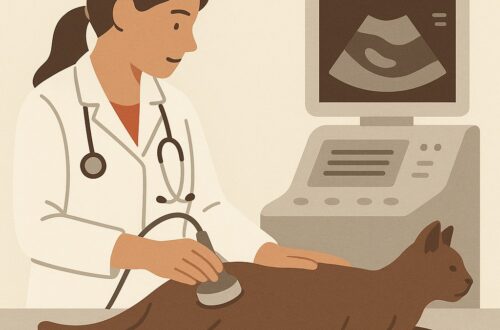I’ve dedicated several posts to variety of eye problems, including keratoconjunctivitis sicca (aka “dry eye”), corneal ulcers, and glaucoma. This week I want to raise awareness of an important cause of acute or sudden blindness in dogs – sudden acquired retinal degeneration syndrome or SARDS. I hope you enjoy this information and will share it with other dog owners. Happy reading!

What is SARDS?
Sudden acquired retinal degeneration syndrome or SARDS is a problem of the retina. The retina is a thin layer of tissue lining the back of the inside of eyes. To date, board-certified veterinary ophthalmologists don’t fully understand why some dogs develop SARDS. Multiple studies have investigated various toxins and apoptosis (cell death) of photoreceptors (unique cells in the retina that respond to light) to no avail.

Some believe SARDS is the result of an immune-mediated attack, but no anti-retina antibodies have been detected in dogs; furthermore, biopsy evaluation of affects eyes has shown no inflammation consistent with immune-mediated destruction. We do know rod and cone photoreceptors are affected simultaneously, and certainly more research is needed to better understand this disease.
What does it look like?
Middle-aged to older patients (mean = 8-10 years of age) are over-represented, as are spayed females. Some breeds appear to have a predisposition for developing SARDS, including pugs, bichon frises, Brittany spaniels, English springer spaniels, American cocker spaniels, beagles, dachshunds, malteses, and miniature schnauzers.

Sudden acquired retinal degeneration syndrome results in abrupt vision loss, typically within a matter of days to a few weeks. Some patients may have a more gradual (i.e.: few months) onset. Affected dogs have both hemerolopia (inability to see in bright light) and nyctolopia (inability to see in dim light or at night). Given the vision loss is relatively sudden, affected dogs are often disoriented and bump into objects. They may be more cautious or unwilling to perform normal activities (i.e.: using stairs) and may develop separation anxiety.
Interestingly, many dogs have systemic clinical signs prior to the onset of acute blindness, including:
- Polypnea (increased panting)
- Polyphagia (increased appetite)
- Polydipsia (increased thirst) & polyuria (abnormally large volume of urine)
- Weight gain
- Lethargy
- Overweight/obesity or recent weight gain
How is SARDS diagnosed?
Dogs with SARDS typically have no structural abnormalities with their eyes. However, their pupils are usually mydriatic (dilated) and do not constrict when a light is directed at the retina. Affected dogs also don’t respond (e.g.: blink) when a menacing gesture (aka flinch) is made directly in front of them.

Dogs with acute vision loss should be evaluated by a board-certified veterinary ophthalmologist as soon as possible. A veterinary ophthalmologist will perform a thorough ophthalmic examination that includes:
- Assessing reflexes
- Examining the fundus to visually inspect the back of the eyes, including the retina
- Performing biomicroscopy to evaluate structures inside the eyes
- Performing tonometry to measure pressure inside the eyes
- Assessing tear production
- Staining the corneas with fluorescein to look for defects
Ultimately, a veterinary ophthalmologist will need to perform a minimally invasive test called electroretinography (ERG). This brief procedure is performed while a patient is under anesthesia, and is used to confirm SARDS and distinguish a dogs’ clinical signs from other causes of acute vision loss.

In addition to a complete ophthalmic examination, non-invasive tests are indicated given common concurrent clinical signs of increased thirst, increased panting, weight gain, increased appetite, and/or lethargy. These tests are:
- Complete blood count
- Biochemical profile
- Urinalysis
- Blood pressure measurement
- Adrenal cortex function tests
- Sex hormone tests
Your primary care doctor and/or board-certified veterinary ophthalmologist may recommend partnering with a board-certified veterinary internal medicine specialist to develop a logical and cost-effective diagnostic plan. There are several potential causes of acute blindness, and making an accurate diagnosis is pivotal.
How is it treated?
To date, there are no specific therapies for SARDS in dogs. Vision loss is permanent. Most affected dogs need a couple of months to adjust to their blindness, and families will need to exercise extra care during this time to protect their dogs and prevent accidental injuries. I encourage owners of blind dogs to read Caroline D. Levin’s book, Living with Blind Dogs, for practical tips to help blind dogs live happy and comfortable lives.

If diagnostic tests document an affected dog is living with increased adrenal cortex function – a problem called hyperadrenocorticism or Cushing’s disease – then a primary care veterinarian or board-certified veterinary internal medicine specialist should initiate appropriate therapy. You can read more about Cushing’s disease here.
The take-away message about SARDS in dogs…
Sudden acquired retinal degeneration syndrome or SARDS is an important cause of acute vision loss in dogs. We don’t yet know what causes this problem, and to date there are no definitive therapies. Interventions are supportive to help affected dogs live comfortable and happy lives.
To find a board-certified veterinary ophthalmologist, please visit the American College of Veterinary Ophthalmologists.
To find a board-certified veterinary internal medicine specialist, please visit the American College of Veterinary Internal Medicine.
Wishing you wet-nosed kisses,
CriticalCareDVM






